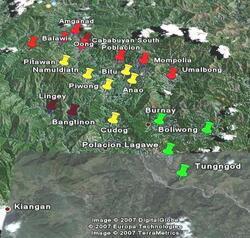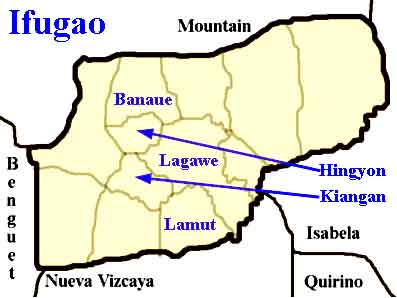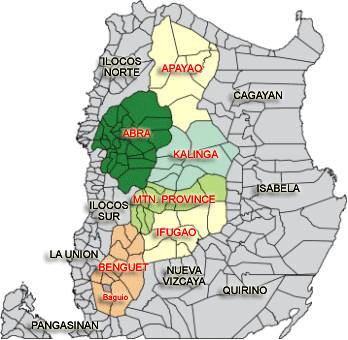Chapter I
BACKGROUND INFORMATION
1.0 Introduction
This chapter talks about the background information about the geography, the peoples, and languages of the central Ifugao people and their relationship with other languages and nearby peoples groups.
1.1 The name of the language
The language variety spoken in the central Ifugao is known to other Ifugao tribes from the adjacent municipalities as the “munkalyon” which literary means ‘those who say kalyon’ and the “mungkgokikgo” as a way of distinguishing the language variety from the “mun’alyon, the “mun’ibanawol” , the “mun’ikiangan”, and the “mun’iyayangan”.
At present the “mungkgokikgo” , a language variety spoken in baranggays Burnay, Boliwong, and Tungngod (that used to include Lagawe Proper) are now being assimilated to the munkalyon. The two are very similar except some few lexical terms; and one of which is the particle “kgokikgo” whose counterpart in the munkalyon is “boppo’oh”. In this paper, I refer to the munkalyon and the munghokigho as the central Ifugao language.
People groups from the southern (Lamut) and south-western (Kiangan, Asipulo, Tinoc) and North-western (Ayangans) sometimes choose to refer to the people by the general location, instead of the language and called them “ihuddokna” or ‘(people) from the up stream’; and when they do that they lump the speakers of both the “mun’alyon” and the “munkalyon”; and they sometimes includes speakers of the “mun’ibannawol” that lived farther north of Hingyon municipality. The referent river most likely meant the "hingyon-banao" river. The said river started from barangay Cababuyan and ended in Ibalao, Tungngod where it joined the bigger Ibulao river.
The people prefer to refer to themselves by their respective place-names: thus both the people groups from the northeastern baranggays of Hingyon that speak the “mun’alyon” dialect, and from the southwestern baranggays of Hingyon that speak the “munkalyon” dialect call themselves either “ihuddoknah” or ‘from the north’ or “ihingyon” or ‘from Hingyon’; and the people from the adjacent baranggays of Lagawe also identify themselves by their place-name refer to themselves as “ilagawe” or ‘from Lagawe’. Both of these groups though speak what I refer to as the ‘central Ifugao language’.
1.2 Ethnology
The dominant economic activity of the people is wet-farming; and even a major part of its religious activities are related its annual farming cycle; and its social leader is one who has had the historically largest land holdings. Supplemental economic activities are combinations of two or more of the following: livestock raising, vegetable production, wood curving, furniture production, micro-business ventures, and various kinds of employments.
The land is largely mountainous and all the higher elevations were covered with communal and family owned forests; the lower hills are dedicated to either housing or to orchard or a combination. Farm lands (wet fields and dry farms) are found along rivers and their tributaries from where irrigations are also drawn. Stone walls are found in rice fields and residential lands. Traditional houses are raised above the ground and were made from a combination of wood, bamboo, and thatched roofing. Modern houses that are made of a combination of reinforced concrete, wood, and galvanized sheets roofing are now replacing the traditional ones.
1.3 Geography and Demography
The language is spoken by inhabitants occupying the general location between latitude 16 52’ 41’’N and 16 47’ 02’’ N and longitude 121 03’ 45’’ E and 121 09’ 20’’ E (http://www.flashearth.com/ google earth, accessed Nov 24, 2007). Digital aerial map marked Map #1 (on following page) and drawn map marked Map #2 show the where the central Ifugao language variety or the “munkalyon is located in relation with the northern Ifugao language or the “mun’alyon” variety is located.
1.4 Physical location
The homeland of the Ifugao (L-complex) language is situated at the central portion of the Cordillera mountain ranges with altitudes ranging from 4,000 to 5,600 feet above sea level. It occupies less than 750 square miles (Bankoti 2004) in center of Northern Luzon.
At the central portion of this land, lies Hingyon-Lagawe, the home of the central Ifugao language variety. Hingyon-Lagawe is generally mountainous and it is bounded on western portion by the Ibulao river, on the southeast by the ridges along Tungngod-Pulaan boundary then to the Boliwong-Jukbong boundary , up to the Burnay-Umalbong boundary; on the northeast by eastern ridge dividing baranggay Anao and Mompolia, and baranggay Bitu and Baranggay Poblacion, and northeast by the political boundaries between Namulditan and Cababuyan, and between Pitawan and Oong; and on the southwest by the mountain ridges along the boundaries dividing Baraggays Namultitan-Piwong-Cudog and Bangtinon and down to the Ibulao river.

Google map of Hingyon-lagawe
The other maps marked Maps #2 and #3 show the general location of land inhabited by the Ifugao tribes in relation to the provinces of northern Luzon, and geographical relationship among the municipalities of Ifugao.

Map #2 above shows the eleven municipalities of the province of Ifugao. The speakers of the central Ifugao language inhabited the southwestern of Hingyon municipality and the western portion of Lagawe Municipality. For lack of an appropriate term, the “munkalyon”

language variety is referred to here as the ‘central Ifugao language’. North of it are speaker of the “mun’alyon”; to the east are the speaker of the “mun’iyangan’; to the south are speakers Ilocano and Ayangan; and to the south is largely the speaker of “tuwali” and “kelei”.
The speakers are largely monolithic, or the people speak the same language. Where there are speakers of the other languages they tend to learn and speak the host language. The four baranggays: Poblacions East, West, North and South of Lagawe is different. There are minority speakers of Ilocano, Tuwali, and Ayangan, and even Tagalog.
The language is used in the homes, in comerce, in social gatherings, in school campuses and classrooms (up to grade III level), and in churches. But some times, Ilocano and central Ifugao languages are largely used when transacting business when either one of the seller or buyer is an Ilocano. Some Ilocano entrepreneurs and residents are trying their best to speak the local language. English is used in written communication among offices, both private and public; while Ilocano and vernacular are used in oral communications both in private and public establishments.
The interactions among language speakers are very cordial and friendly. People generally have the tendency to speak the host language where ever they are. The “Munkalyon” or central Ifugao language variety and the “tuwali” language are markedly dominant among all other language. Speakers of these two languages tend to speak their respective language where ever they are, even when they are in any of the adjacent provinces; when speakers of the two language groups meet, each language group speak their own respective language when interacting or conversing with the other. It may be because the two language varieties are very similar and understandable among them.
In terms of temperament, both the “mun’alyon” and the central Ifugao language speakers, the “munkayon” equally dominant. This trait is observable in political activities, employment in government offices, in leadership in religious organizations, and in police blotters.
1.5 Genetic affiliation
The central Ifugao language is genetically affiliated with the Northern Philippine languages (McFarland 1980 and Ethnologue 2000). The ethnologue however further subdivided Northern Philippine languages into Northern Luzon and Southern Luzon, whereas McFarland considered it as one gene languages. McFarland divided the Northern Philippines languages into cordillera languages, Ilongots , and Sambalic languages; cordillera languages was in turn divided into Dumagat languages, Northern cordillera languages, Ilocano, Central cordillera languages, and Southern Cordillera languages; Central Cordillera languages was further divided into Kalinga, Itneg, Balangaw, Bontoc, Kankanaey, Ifugao (L-complex), and Isinai; finally, the Ifugao (L-complex) languages was subdivided into Ifugao-Eastern, Ifugao-Kiangan, and Ifugao-Banaue. The genetic affiliation of the Ifugao (L-complex) language following McFarland model would then look like Figure 1.1 below. It can be contrasted to that of Gordon found in Etnologue in Figure 1.2 and also that of Reid’s, Figure1.3.
Figure 1.1 McFarland 1980
Figure 1.2 Etnologue (Gordon 2005)
Linguistic Lineage for Ifugao, Amganad (northern and central Ifugao language varieties):
Austronesian (1268)
Malayo-Polynesian (1248)
Northern Philippine (72)
Northern Luzon (56)
South-Central Cordilleran (33)
Central Cordilleran (23)
Ifugao (4)
Ifugao, Amganad [ifa]
(Mun’alyon/ northern)
(Munkalyon/ central)
(Mun’ibannawol)
Gordon, Raymond G., Jr. (ed.), 2005. Ethnologue: Languages of the World, Fifteenth edition. Dallas, Tex.: SIL International. Online version: http://www.ethnologue.com/. Accessed November 25, 2007.
Figure 1.3 (Reid 1974)
Central Cordilleran
Meso Cordilleran
South-Central Cordilleran
Central Cordilleran
North-Central Cordilleran
Nuclear Cordilleran
Isanai Ifugao Balangao Kankanay Bontoc Kalingga Isneg
The Ifugao-Banaue (or Ifugao Amganad) language has varieties, the “mun'alyon” dialect and the “munkalyon” dialect. The “munkalyon” is the focus of this research paper and I refer to it as the ‘central Ifugao language’ (or dialect). The Ifugao-Banaue language is one of the three major Ifugao language varieties spoken in the province of Ifugao, the other two are Ifugao-Eastern (Ayangan) and Ifugao Kiangan (Tuwali). Keley'i is another language variety spoken in the south-western portion of Ifugao, but it is more related to the Kalanguya language, which is spoken along the Ifugao-Benguet-Neuva Vizcaya boundary. This central Ifugao dialect, or the “mun'kalyon”, is spoken in thirteen baranggays starting from baranggay Pitawan, municipality of Hingyon in the north to baranggay Tungod, municipality of Lagawe in the south. The thirteen baranggays are Pitawan, Namuldita, Piwong, Bitu, and Anao, all in the municipality of Hingyon; baranggays Burnay, Cudog, Boliwong, Poblacion North, Poblacion West, Pablacion East, Poblacion South, and Tungod, all in the municipality of Lagawe. The total population in all these thirteen baranggays is about 12,548 according to the NSO 1995 census (http://www.ifugao.gov.ph/barangays.htm accessed November 25, 2007).
On the other hand, northern Ifugao dialect or the “mun'alyon” is spoken in the eight northeastern baranggays more particularly baranggays Amganad, Tam’an, and Balawis in the municipality of Banaue, baranggays Cababuyan North, Cababuyan South, Poblacion, Mompolia, and Umalbong, all in the municipality of Hingyon.
The distinctive difference of the central Ifugao dialect and northern Ifugao dialect varieties of the so called Ifugao Amganad or Ifugao-Banawe is the use of velar voiceless plosive /k/ in place of glottal stop /ʔ/ in some of the lexemes. These two dialect varieties and those spoken in the other western baranggays of Banawe or the “’ibanawol” are lumped together and labeled as Ifugao Amganad or Ifugao-Banawe language by Raymond Gordon (ethnologue 2000) and is entered in the ethnologue three-letter code as “IFA”.
Raumond Gordon in the ethnologue included the other western baranggays of the municipality of Banaue, more particularly barangays Bocos, View Point, Gohang, San Fernando, Poblacion and Tam-an to the Ifugao-Banawe (or Ifugao Amganad) language. The speakers in these barangays, however, speak a some what different variety that have extra phonemes like [c, j, s, and r] (Llamzon 1978, p58) that is absent in the phonemes of both the northern and central Ifugao languages/dialects. The rest of the baranggays of Banawe speak the Banawe-eastern or the Batad Ifugao (or Ayangan) language variety.
There are other speakers of the Ifugao (L-complex) language scattered nationwide. It was reported that it comprise a majority in municipalities of Ambaguio and Kayapa, large minority in Kasibu and Diadi, a small minority in Barangay Villa Verde, municipality of Solano, all in province of Nueva Vizcaya; large minority language spoken in the municipality of Maddela, small minority in Cabarrogis, Aglipay, and Diffun, all in the province of Quirino (McFarland 1980). There are small communities in city of Malaybalay, Bukidnon, and in the municipality Ramon, Isabela, and in the municipality of Tuba, Benguet and Baguio city (personal knowledge). There are undetermined number of speakers of the language in other places in the Philippines.
1.6 Sociolinguistics setting of the Ifugaos
The people of Ifugao are closely related to the other tribes inhabiting the grand cordillera and calballo mountain ranges. Today they are separated into the two regional political and administrative units and called Cordillera Administrative Region or CAR. In the past, the Spaniards lamped all the people of mountainous lands of Northern Luzon and called them Ygolot, Igorrotes, Igorotes or Igorot (Henry Scott 1974, pp 169f). Later the term was used to designate the peoples groups of the old Mountain Province comprising Benguet, Ifugao, Bontoc, Kalinga and Apayao (Scott 1974, p 310, www.britannica.com/eb/article-9042068/Igorot). Often times the people of Kalinga and Ifugao excludes themselves from being called Igorot.
The Ifugao is sometimes called Ifugaw, Ipugao, Ypugao, Hilipan, or Quiangan by outsiders (Peralta 2000). Peralta (erroneously) reported that Ifugao is host to six different language varieties: Kiangan-Hapao, Banaue-Burnay, Ayangan-Mayoyao, Hungduan (mistakenly named Hanglulu), Tuwali, and Keleyi. There may actually be only four language varieties; tuwali is the language name of the group of people who inhabited in the Kiangan-Hungduan area (municipalities). Hapao is adjacent to and one of the baranggays of Hungduan. He further reported that there were 167,369 speakers of the Ifugao language in 1990 (Peralta 2000, p 19).
The National Statistics Office it its 2000 census reported that total population of Ifugao province is 161,623.
Social life: Villages or hamlets (bobleh) of as many as eight to twelve dwellings (Encyclopedia of South-East Asian Ethnography pp256), housing an equal number of families or lesser, are built on hillocks at the sides of valleys or on top of hills overlooking rice fields. Separate houses of for rice storage or granaries (alang) are built within these villages and owed by the wealthy landed families (kadangyan) who may not necessarily be residents of the village. Houses are made of timber, bamboos, and rest on four posts, with thatch roofs. Residential houses are usually larger, have shelves (patye) all around the four sides of the wall and have hearths (pundapulan) while granaries don't have hearths nor shelves.
Some villages have temporary residential buildings built on the ground (abung or abbung) and a few have bigger modern buildings (pinadel) whose design is borrowed from the lowlanders. These modern buildings have more than two rooms and may house more than one nuclear families and/or partly serve as rice storage all at the same time. Some villages have a dormitory house for adult unmarried women or for unmarried men that serve as sleeping quarters (agamang); bigger villages may have both. Dormitories for women are under the under the supervision of aged widows. Families who live in modern residential buildings have rooms for unmarried women and/or unmarried men.
1.7 Previous studies on Ifugao
1.7.1 Non-linguistic studies
N. S. Bisht and T. S. Bankoti in their studies on South-East Asian Ethnography came with the description of the social, political and religious life of the different peoples group, which include among others, Ifugao people in general.
William Henry Scott came up with study of the political and economic struggles of the Igorots or the peoples of the greater cordillera mountain ranges during the three and a half century Spanish occupation of the Philippines. Toh Godah (2001) of Japan made a comparative anthropological study of the cultures of Bontok and Ifugao.
A home-grown writer in the person of Lourdes Dulawan, (1984), came up with an anthropological study on the religious practices “baki” of the “tuwali” or Kiangan peoples group. These cultural practices are, except for some few details, very identical among all the Ifugao tribes.
1.7.2 Linguistic studies
Lawrence Reid made a comparative phonological and morphological studies of the Central Cordillera languages that made him classify this group of seven languages; with Bontok-kankanaey, Balangaw, and Ifugao forming a sub-group he called Nuclear Cordillera that joined the Kalinga-Itneg sub-group into what he called North Central Cordillera. He also made phonological studies on Philippines languages (1971) where he came out with orthographies of, among others, three Ifugao language variations, specifically that of Amganad, Batad, and Bayninan language variations.
Leonard Newell (1971) made a report on the Types of Independent Clauses of the Batad (Ifugao Eastern) language variation. Anne West of the Summer Institutes of Linguistics came up with an unpublished manuscript on the Amganad phonology.
1.8 Methodology Fieldworks
The corpus on which this paper is based upon composed of data extracted from audio texts of some four discourses, a few were culled from data gathered by Anne West and Funnel (West, 1983), and elicited data in 2006 from the researcher himself which was used for a phonology paper of a group of four AGS students, of which this researcher is a member, as well as data from personal memory of the researcher himself.
